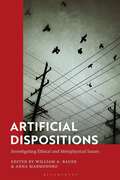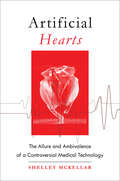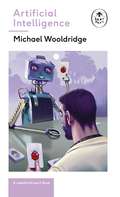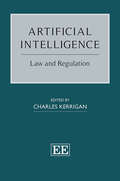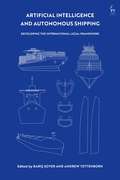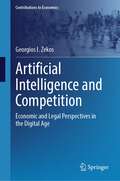- Table View
- List View
Articles of Association: Guidance and Precedents (Directors' Handbook Series)
by Richard BishopNearly four million companies incorporated in the UK allow their constitution or company rule book to be dictated by the standard Articles of Association. Designed to aid professional advisers, directors and shareholders make better decisions about any company's constitution, this book provides:- The background to the articles of association, the Company Law act 2006, business structures and their needs.- A review of the case law and the implications for amending the articles of association- A detailed analysis of the default Articles of association proscribed in The Companies (Model Articles) Regulations 2008 Table A.- A guide to drafting articles of association, real life examples and discussions on why companies should adapt Table A to suit specific company requirements.- All precedents are available as electronic downloadsSolicitors and accountants will have the tools to confidently advise clients on how the articles of association impacts on the company and with clever drafting how the constitution of the company can be amended to provide clear provisions to suit its strategic position. For those who may wish to consider changing the constitution of their own company, the book is full of practical examples, together with do's and don'ts, and illustrations and full procedures for trustees, family investment and property companies providing guidelines for minority shareholders, investors and directors.
Articles of Faith: Religion, Secularism, and the Indian Supreme Court
by Ronojoy SenExamining the constitutional and legal foundations of the place of religion in India, Articles of Faith studies the relationship between religion and state. It closely analyses the decisions of the Supreme Court from the 1950s on Articles 25–30 of the Indian Constitution, as well as other relevant laws and constitutional provisions. The book discusses the Supreme Court’s interpretation of the constitutional right to freedom of religion and its influence on the discourse of secularism and nationalism. While examining the role of the Court in defining and demarcating religion as well as religious freedom, practices, and organizations, this volume also highlights important issues such as interpretative traditions and legal doctrines developed by the judiciary over the years. This new edition has an expanded and revised introduction, which looks at the new literature on secularism and religious jurisprudence, both in India and other secular democracies. It also includes an afterword, which examines recent landmark judgments on religion by the Supreme Court of India, such as the one on triple talaq.
Articulating Intersex: A Crisis at the Intersection of Scientific Facts and Social Ideals (Philosophy and Medicine #131)
by Natalie DelimataThis book explores the ethical dilemma clinicians may face when disclosing a diagnosis of atypical sex. The moment of disclosure reveals an epistemic incompatibility between scientific fact and social meaning in relation to sex. Attempting to assess the bio-psychosocial implications of this dilemma highlights a complex historic antagonism between fact and meaning making satisfactory resolution of this dilemma difficult. Drawing on David Hume, WVO Quine and Michel Foucault the author presents an integrative model, which views scientific fact and social meaning as codetermining threads in one fabric of knowledge. From this epistemic perspective, the ethical dilemma is understood as a tear in the fabric signifying a rupturing of ontological integrity. To mend this tear and resolve the ethical dilemma three metaphysical perspectives are considered: essentialism, naturalism and emergentism. The book’s unique features include: an exploration of the impact of diagnostic disclosure on people with atypical sex (intersex); a synthesis of the epistemic perspectives of social and natural science facilitating interdisciplinary collaboration; a critical evaluation of three metaphysical perspectives on atypical sex (intersex); the application of Hume’s epistemological and moral distinctions to contemporary biomedicine and bioethics. The book’s target audience includes academics, students and professionals whose work intersects the natural and social sciences, and individuals interested in the metaphysics, epistemology and meta-ethics of sex.
Articulating the Moral Community: Toward a Constructive Ethical Pragmatism (Oxford Moral Theory)
by Henry RichardsonIs morality fixed objectively, independently of all human judgment, or do we "invent" right and wrong? Articulating the Moral Community argues that neither of these simple answers is correct. Its central thesis is that, working within zones of objective indeterminacy, the moral community-the community of all persons-has the authority to introduce new moral norms. Unlike political communities, which are centralized, non-inclusive, and backed by coercion, the moral community is decentralized, inclusive, and not coercively backed. This book explains in detail how its structure arises from efforts by individuals to work out intelligently with one another how to respond to morally important concerns. Developing a novel theory of dyadic rights and duties based on this phenomenon, the book argues that conscientious efforts of this kind provide moral input, authoritative only over the parties involved. After sufficient uptake and reflective acceptance by the moral community, however, these innovations become new moral norms. This account of the moral community's moral authority is motivated by, and supports, a type of normative ethical theory, constructive ethical pragmatism, which-to use an unfashionable distinction defended in the book-rejects the consequentialist claim that rightness is to be defined as a function of goodness and the deontological claim that principles of right stand fixed, independently of the good. It holds, rather, that what we ought to do depends on our continuing efforts to specify the right and the good in light of each other.
Articulating the Moral Community: Toward a Constructive Ethical Pragmatism (Oxford Moral Theory)
by Henry RichardsonIs morality fixed objectively, independently of all human judgment, or do we "invent" right and wrong? Articulating the Moral Community argues that neither of these simple answers is correct. Its central thesis is that, working within zones of objective indeterminacy, the moral community-the community of all persons-has the authority to introduce new moral norms. Unlike political communities, which are centralized, non-inclusive, and backed by coercion, the moral community is decentralized, inclusive, and not coercively backed. This book explains in detail how its structure arises from efforts by individuals to work out intelligently with one another how to respond to morally important concerns. Developing a novel theory of dyadic rights and duties based on this phenomenon, the book argues that conscientious efforts of this kind provide moral input, authoritative only over the parties involved. After sufficient uptake and reflective acceptance by the moral community, however, these innovations become new moral norms. This account of the moral community's moral authority is motivated by, and supports, a type of normative ethical theory, constructive ethical pragmatism, which-to use an unfashionable distinction defended in the book-rejects the consequentialist claim that rightness is to be defined as a function of goodness and the deontological claim that principles of right stand fixed, independently of the good. It holds, rather, that what we ought to do depends on our continuing efforts to specify the right and the good in light of each other.
The Artifactual Nature of Law (IVR Studies in the Philosophy of Law and Social Philosophy)
This thought-provoking book develops and elaborates on the artifact theory of law, covering a wide range of related theoretical and practical topics. Offering a range of perspectives that flesh out the artifact theory of law, it also introduces criticisms of previous formulations of the theory and inquires into its potential payoffs.Featuring international contributions from both noted and up-and-coming scholars in law and philosophy, the book is divided into two parts. The first part further explores and evaluates the concept of law as an artifact and analyses the background and theoretical basis of the theory. The second part comprises three sections on legal ontology, semantics and legal normativity, specifically in relation to law’s artifactual nature.Providing cutting-edge insights at the intersection of law and philosophy, this book will appeal to scholars and students in philosophy of law, empirical legal studies, social ontology and the philosophy of society.
Artificial Dispositions: Investigating Ethical and Metaphysical Issues
by William A. Bauer and Anna MarmodoroWe inhabit a world not only full of natural dispositions independent of human design, but also artificial dispositions created by our technological prowess. How do these dispositions, found in automation, computation, and artificial intelligence applications, differ metaphysically from their natural counterparts? This collection investigates artificial dispositions: what they are, the roles they play in artificial systems, and how they impact our understanding of the nature of reality, the structure of minds, and the ethics of emerging technologies. It is divided into four parts covering the following interconnected themes: (i) Artificial and Natural Dispositions, (ii) Artificial Systems and Their Dispositions, (iii) Agency, Mind, and Artificial Dispositions, and (iv) Artificial Moral Dispositions. This is a groundbreaking and thought-provoking resource for any student or scholar of philosophy of science, contemporary metaphysics, applied ethics, philosophy of mind, and philosophy of technology.
Artificial Dispositions: Investigating Ethical and Metaphysical Issues
We inhabit a world not only full of natural dispositions independent of human design, but also artificial dispositions created by our technological prowess. How do these dispositions, found in automation, computation, and artificial intelligence applications, differ metaphysically from their natural counterparts? This collection investigates artificial dispositions: what they are, the roles they play in artificial systems, and how they impact our understanding of the nature of reality, the structure of minds, and the ethics of emerging technologies. It is divided into four parts covering the following interconnected themes: (i) Artificial and Natural Dispositions, (ii) Artificial Systems and Their Dispositions, (iii) Agency, Mind, and Artificial Dispositions, and (iv) Artificial Moral Dispositions. This is a groundbreaking and thought-provoking resource for any student or scholar of philosophy of science, contemporary metaphysics, applied ethics, philosophy of mind, and philosophy of technology.
Artificial Hearts: The Allure and Ambivalence of a Controversial Medical Technology
by Shelley McKellarArtificial hearts are seductive devices. Their promissory nature as a cure for heart failure aligned neatly with the twentieth-century American medical community;€™s view of the body as an entity of replacement parts. In Artificial Hearts, Shelley McKellar traces the controversial history of this imperfect technology beginning in the 1950s and leading up to the present day. McKellar profiles generations of researchers and devices as she traces the heart;€™s development and clinical use. She situates the events of Dr. Michael DeBakey and Dr. Denton Cooley;€™s professional fall-out after the first artificial heart implant case in 1969, as well as the 1982;€“83 Jarvik-7 heart implant case of Barney Clark, within a larger historical trajectory. She explores how some individuals;¢;‚¬;€?like former US Vice President Dick Cheney;¢;‚¬;€?affected the public profile of this technology by choosing to be implanted with artificial hearts. Finally, she explains the varied physical experiences, both negative and positive, of numerous artificial heart recipients. McKellar argues that desirability;¢;‚¬;€?rather than the feasibility or practicality of artificial hearts;¢;‚¬;€?drove the invention of the device. Technical challenges and unsettling clinical experiences produced an ambivalence toward its continued development by many researchers, clinicians, politicians, bioethicists, and the public. But the potential and promise of the artificial heart offset this ambivalence, influencing how success was characterized and by whom. Packed with larger-than-life characters;¢;‚¬;€?from dedicated and ardent scientists to feuding Texas surgeons and brave patients;¢;‚¬;€?this book is a fascinating case study that speaks to questions of expectations, limitations, and uncertainty in a high-technology medical world.
Artificial Hearts: The Allure and Ambivalence of a Controversial Medical Technology
by Shelley McKellarArtificial hearts are seductive devices. Their promissory nature as a cure for heart failure aligned neatly with the twentieth-century American medical community;€™s view of the body as an entity of replacement parts. In Artificial Hearts, Shelley McKellar traces the controversial history of this imperfect technology beginning in the 1950s and leading up to the present day. McKellar profiles generations of researchers and devices as she traces the heart;€™s development and clinical use. She situates the events of Dr. Michael DeBakey and Dr. Denton Cooley;€™s professional fall-out after the first artificial heart implant case in 1969, as well as the 1982;€“83 Jarvik-7 heart implant case of Barney Clark, within a larger historical trajectory. She explores how some individuals;¢;‚¬;€?like former US Vice President Dick Cheney;¢;‚¬;€?affected the public profile of this technology by choosing to be implanted with artificial hearts. Finally, she explains the varied physical experiences, both negative and positive, of numerous artificial heart recipients. McKellar argues that desirability;¢;‚¬;€?rather than the feasibility or practicality of artificial hearts;¢;‚¬;€?drove the invention of the device. Technical challenges and unsettling clinical experiences produced an ambivalence toward its continued development by many researchers, clinicians, politicians, bioethicists, and the public. But the potential and promise of the artificial heart offset this ambivalence, influencing how success was characterized and by whom. Packed with larger-than-life characters;¢;‚¬;€?from dedicated and ardent scientists to feuding Texas surgeons and brave patients;¢;‚¬;€?this book is a fascinating case study that speaks to questions of expectations, limitations, and uncertainty in a high-technology medical world.
Artificial Integrity: The Paths to Leading AI Toward a Human-Centered Future
by Hamilton MannNavigating the transitions to the future of AI—Integrity over Intelligence Envision a world where artificial intelligence can deliver integrity-led outcomes seamlessly, adapting to diverse cultural context, value models, and situational nuances, countering subconscious biases, all while operating in an advanced human-centered manner. This is the promise of Artificial Integrity. In Artificial Integrity, digital strategist, technologist, doctoral researcher, acclaimed management thinker, and seasoned business executive Hamilton Mann emphasizes that the challenge of AI is in ensuring systems that exhibit integrity-led capabilities over the pursuit of mere general or super intelligence. Mann tackles the inadequacies of traditional ethical frameworks in handling the complexities of new AI technologies to make them trustworthy and reliable as they profoundly impact human lives. Introducing the transformative concept of “artificial integrity,” Mann proposes a paradigm shift, defining a “code of design” to ensure AI systems align with, amplify, and sustain human values and societal norms, maximizing integrity-led AI outcomes. Artificial Integrity discusses practical insights into driving a future where AI enhances, without replacing, human capabilities while being inclusive and reflective of diverse human experiences, emphasizing human agency. The book offers: Guiding posts and step-by-step solutions for designing, implementing and continuously aligning AI development to responsibly advance human and artificial co-intelligence Strategies and actionable advice for integrating AI into business and societal structures Practical paths toward managing the transition to the future of AI for human productivity and decision-making while maintaining sustainable trustworthiness Artificial Integrity is essential for anyone involved in AI development, from executives, business leaders, and managers to entrepreneurs, tech enthusiasts and policymakers. It's also perfect for laypeople interested in how AI intersects with society. Dive into this compelling and thought provoking read to ensure you are prepared for the challenges and opportunities that lie ahead in a human-centered AI-driven future.
Artificial Integrity: The Paths to Leading AI Toward a Human-Centered Future
by Hamilton MannNavigating the transitions to the future of AI—Integrity over Intelligence Envision a world where artificial intelligence can deliver integrity-led outcomes seamlessly, adapting to diverse cultural context, value models, and situational nuances, countering subconscious biases, all while operating in an advanced human-centered manner. This is the promise of Artificial Integrity. In Artificial Integrity, digital strategist, technologist, doctoral researcher, acclaimed management thinker, and seasoned business executive Hamilton Mann emphasizes that the challenge of AI is in ensuring systems that exhibit integrity-led capabilities over the pursuit of mere general or super intelligence. Mann tackles the inadequacies of traditional ethical frameworks in handling the complexities of new AI technologies to make them trustworthy and reliable as they profoundly impact human lives. Introducing the transformative concept of “artificial integrity,” Mann proposes a paradigm shift, defining a “code of design” to ensure AI systems align with, amplify, and sustain human values and societal norms, maximizing integrity-led AI outcomes. Artificial Integrity discusses practical insights into driving a future where AI enhances, without replacing, human capabilities while being inclusive and reflective of diverse human experiences, emphasizing human agency. The book offers: Guiding posts and step-by-step solutions for designing, implementing and continuously aligning AI development to responsibly advance human and artificial co-intelligence Strategies and actionable advice for integrating AI into business and societal structures Practical paths toward managing the transition to the future of AI for human productivity and decision-making while maintaining sustainable trustworthiness Artificial Integrity is essential for anyone involved in AI development, from executives, business leaders, and managers to entrepreneurs, tech enthusiasts and policymakers. It's also perfect for laypeople interested in how AI intersects with society. Dive into this compelling and thought provoking read to ensure you are prepared for the challenges and opportunities that lie ahead in a human-centered AI-driven future.
Artificial Intelligence: Everything you need to know about the coming AI. A Ladybird Expert Book (The Ladybird Expert Series #1600)
by Michael Wooldridge'I propose to consider the question, 'Can machines think?' Alan Turing (1950)Part of the ALL-NEW Ladybird Expert series.This book is for everyone living in the age of Artificial Intelligence. And this is an accessible and authoritative introduction to one of the most important conversations of our time . . . Written by computer scientist Michael Wooldridge, Artificial Intelligence chronicles the development of intelligent machines, from Turing's dream of machines that think, to today's digital assistants like Siri and Alexa. AI is not something that awaits us in the future. Inside you'll learn how we have come to rely on embedded AI software and what a world of ubiquitous AI might look like.What's inside?- The British mathematician Alan Turing- Can machines 'understand'?- Logical and Behavioural AI- The reality of AI today- AI tomorrow- And much more . . . For an adult readership, the Ladybird Expert series is produced in the same iconic small hardback format pioneered by the original Ladybirds. Each beautifully illustrated book features the first new illustrations produced in the original Ladybird style for nearly forty years.
Artificial Intelligence: Law and Regulation
This timely book provides an extensive overview and analysis of the law and regulation as it applies to the technology and uses of Artificial Intelligence (AI). It examines the human and ethical concerns associated with the technology, the history of AI and AI in commercial contexts.Written by outstanding lawyers, technologists and other professionals, this book will help readers acquire an understanding of the taxonomy of AI, the legal rules that apply to AI and the way AI has been utilised in various commercial contexts.Key features include:explanation of the technology and practical legal issues relating to the use of AIexploration of AI in the traditional legal categories; including contract and tort lawchapters written by procurement, legaltech, algorithm auditing and other professionalsuse cases from the main industries utilising the technology, such as financial services, real estate and insurance.Artificial Intelligence will help to further readers’ engagement with AI and enable them to ask themselves the right questions while doing so. It will prove a crucial reference point for all lawyers, policy makers and academics with an interest in the interaction between law and AI, and to any lawyer with clients that use or consider using AI in their business.
Artificial Intelligence and Autonomous Shipping: Developing the International Legal Framework
by Barış Soyer and Andrew TettenbornThis collection of essays critically evaluates the legal framework necessary for the use of autonomous ships in international waters. The work is divided into three parts:Part 1 evaluates how far national shipping regulation, and the public international law background that lies behind it, may need modification and updating to accommodate the use of autonomous ships on international voyages. Part 2 deals with private law and insurance issues such as collision and pollution liability, salvage, limitation of liability and allocation of risk between carrier and cargo interests. Part 3 analyses international convention regimes dealing with maritime safety and other matters, arguing for specific changes in the existing conventions such as SOLAS and MARPOL, which would provide the international framework that is necessary for putting autonomous ships into commercial use. The book also takes the view that amendment of international conventions is important in the case of liability issues, arguing that leaving such matters to national law, particularly issues concerning product liability, could not only restrict or hinder the availability of liability insurance but also hamper the development of technology in this field.Written by internationally-known experts in their respective areas, the book offers a holistic approach to the debate on autonomous ships and makes a timely and important contribution to the literature.
Artificial Intelligence and Autonomous Shipping: Developing the International Legal Framework
This collection of essays critically evaluates the legal framework necessary for the use of autonomous ships in international waters. The work is divided into three parts:Part 1 evaluates how far national shipping regulation, and the public international law background that lies behind it, may need modification and updating to accommodate the use of autonomous ships on international voyages. Part 2 deals with private law and insurance issues such as collision and pollution liability, salvage, limitation of liability and allocation of risk between carrier and cargo interests. Part 3 analyses international convention regimes dealing with maritime safety and other matters, arguing for specific changes in the existing conventions such as SOLAS and MARPOL, which would provide the international framework that is necessary for putting autonomous ships into commercial use. The book also takes the view that amendment of international conventions is important in the case of liability issues, arguing that leaving such matters to national law, particularly issues concerning product liability, could not only restrict or hinder the availability of liability insurance but also hamper the development of technology in this field.Written by internationally-known experts in their respective areas, the book offers a holistic approach to the debate on autonomous ships and makes a timely and important contribution to the literature.
Artificial Intelligence and Bioethics (SpringerBriefs in Ethics)
by Perihan Elif Ekmekci Berna ArdaThis book explores major bioethical issues emerging from the development and use of artificial intelligence in medical settings. The authors start by defining the past, present and future of artificial intelligence in medical settings and then proceed to address the resulting common and specific bioethical inquiries. The book discusses bioethical inquiries in two separate sets. The first set is comprised of ontological discussions mainly focusing on personhood and being an ethical agent of an artefact. The second set discusses bioethical issues resulting from the use of artificial intelligence. It focuses particularly on the area of artificial intelligence use in medicine and health services. It addresses the main challenges by considering fundamental principles of medical ethics, including confidentiality, privacy, compassion, veracity and fidelity. Finally, the authors discuss the ethical implications of involvement of artificial intelligence agents in patient care by expanding on communication skills in a case-based approach. The book is of great interest to ethicists, medical professionals, academicians, engineers and scientists working with artificial intelligence.
Artificial Intelligence and Blockchain in Digital Forensics (River Publishers Series in Digital Security and Forensics)
by P. Karthikeyan Hari Mohan Pande Velliangiri SarveshwaranDigital forensics is the science of detecting evidence from digital media like a computer, smart phone, server, or network. It provides the forensic team with the most beneficial methods to solve confused digital-related cases. AI and blockchain can be applied to solve online predatory chat cases and photo forensics cases, provide network service evidence, custody of digital files in forensic medicine, and identify roots of data scavenging. The increased use of PCs and extensive use of internet access, has meant easy availability of hacking tools. Over the past two decades, improvements in the information technology landscape have made the collection, preservation, and analysis of digital evidence extremely important. The traditional tools for solving cybercrimes and preparing court cases are making investigations difficult. We can use AI and blockchain design frameworks to make the digital forensic process efficient and straightforward. AI features help determine the contents of a picture, detect spam email messages and recognize swatches of hard drives that could contain suspicious files. Blockchain-based lawful evidence management schemes can supervise the entire evidence flow of all of the court data. This book can provide a wide-ranging overview of how AI and blockchain can be used to solve problems in digital forensics using advanced tools and applications available on the market.
Artificial Intelligence and Blockchain in Digital Forensics (River Publishers Series in Digital Security and Forensics)
by P. Karthikeyan Hari Mohan Pandey Velliangiri SarveshwaranDigital forensics is the science of detecting evidence from digital media like a computer, smart phone, server, or network. It provides the forensic team with the most beneficial methods to solve confused digital-related cases. AI and blockchain can be applied to solve online predatory chat cases and photo forensics cases, provide network service evidence, custody of digital files in forensic medicine, and identify roots of data scavenging. The increased use of PCs and extensive use of internet access, has meant easy availability of hacking tools. Over the past two decades, improvements in the information technology landscape have made the collection, preservation, and analysis of digital evidence extremely important. The traditional tools for solving cybercrimes and preparing court cases are making investigations difficult. We can use AI and blockchain design frameworks to make the digital forensic process efficient and straightforward. AI features help determine the contents of a picture, detect spam email messages and recognize swatches of hard drives that could contain suspicious files. Blockchain-based lawful evidence management schemes can supervise the entire evidence flow of all of the court data. This book can provide a wide-ranging overview of how AI and blockchain can be used to solve problems in digital forensics using advanced tools and applications available on the market.
Artificial Intelligence and Competition: Economic and Legal Perspectives in the Digital Age (Contributions to Economics)
by Georgios I. ZekosThis book examines the impact of artificial intelligence on competition and antitrust in today's global digital economy. It scrutinizes the economic and legal ramifications of Artificial Intelligence (AI), addressing the challenges it presents to competition and the law.Beginning with an analysis of AI's developments across various economic sectors, the book highlights the need for updated legislation. It focuses on the digital economy, emphasizing digital platforms' role in shaping competition. Econometric investigations and a novel index assess competition's influence on foreign direct investment and multinational enterprises. Comparing competition practices across jurisdictions like the EU, US, Germany, and China, the book uncovers commonalities and differences in competition law principles. It also explores various theories on competition and competition law, seeking convergence or divergence.This book is an essential resource for scholars, legal professionals, policymakers, and anyone seeking a better understanding of how AI is reshaping competition and antitrust in the digital age.
Artificial Intelligence and Global Security: Future Trends, Threats and Considerations
by Yvonne R. MasakowskiArtificial Intelligence and Global Security: Future Trends, Threats and Considerations brings a much-needed perspective on the impact of the integration of Artificial Intelligence (AI) technologies in military affairs. Experts forecast that AI will shape future military operations in ways that will revolutionize warfare. That is why there is an urgent need to consider the potential ethical and moral consequences related to enabling AI to make decisions that will shape the future world. This book masterfully presents a vision of a future that is replete with integrated networks of Artificial Intelligence that are designed to both defend and attack nations. Artificial Intelligence and Global Security: Future Trends, Threats and Considerations has rendered a major service to those interested in the impact of Artificial Intelligence technologies and its contribution to the evolution and revolution in military warfare. It will also explore questions such as: What are the implications of AI for the individual, for personal identity, for society, and for global security? And examine the impact of AI on Just War Theory, as well as the perspectives and consequences for the integration of AI in our daily lives and society.
Artificial Intelligence and Global Security: Future Trends, Threats and Considerations
by Yvonne R. MasakowskiArtificial Intelligence and Global Security: Future Trends, Threats and Considerations brings a much-needed perspective on the impact of the integration of Artificial Intelligence (AI) technologies in military affairs. Experts forecast that AI will shape future military operations in ways that will revolutionize warfare. That is why there is an urgent need to consider the potential ethical and moral consequences related to enabling AI to make decisions that will shape the future world. This book masterfully presents a vision of a future that is replete with integrated networks of Artificial Intelligence that are designed to both defend and attack nations. Artificial Intelligence and Global Security: Future Trends, Threats and Considerations has rendered a major service to those interested in the impact of Artificial Intelligence technologies and its contribution to the evolution and revolution in military warfare. It will also explore questions such as: What are the implications of AI for the individual, for personal identity, for society, and for global security? And examine the impact of AI on Just War Theory, as well as the perspectives and consequences for the integration of AI in our daily lives and society.
Artificial Intelligence and Healthcare: The Impact of Algorithmic Bias on Health Disparities (The International Library of Bioethics #107)
by Natasha H. WilliamsThis book explores the ethical problems of algorithmic bias and its potential impact on populations that experience health disparities by examining the historical underpinnings of explicit and implicit bias, the influence of the social determinants of health, and the inclusion of racial and ethnic minorities in data. Over the last twenty-five years, the diagnosis and treatment of disease have advanced at breakneck speeds. Currently, we have technologies that have revolutionized the practice of medicine, such as telemedicine, precision medicine, big data, and AI. These technologies, especially AI, promise to improve the quality of patient care, lower health care costs, improve patient treatment outcomes, and decrease patient mortality. AI may also be a tool that reduces health disparities; however, algorithmic bias may impede its success. This book explores the risks of using AI in the context of health disparities. It is of interest to health services researchers, ethicists, policy analysts, social scientists, health disparities researchers, and AI policy makers.
Artificial Intelligence and Human Rights
by Jeroen Temperman Alberto QuintavallaThe scope of Artificial Intelligence's (AI) hold on modern life is only just beginning to be fully understood. Academics, professionals, policymakers, and legislators are analysing the effects of AI in the legal realm, notably in human rights work. Artificial Intelligence technologies and modern human rights have lived parallel lives for the last sixty years, and they continue to evolve with one another as both fields take shape. Human Rights and Artificial Intelligence explores the effects of AI on both the concept of human rights and on specific topics, including civil and political rights, privacy, non-discrimination, fair procedure, and asylum. Second- and third-generation human rights are also addressed. By mapping this relationship, the book clarifies the benefits and risks for human rights as new AI applications are designed and deployed. Its granular perspective makes Human Rights and Artificial Intelligence a seminal text on the legal ramifications of machine learning. This expansive volume will be useful to academics and professionals navigating the complex relationship between AI and human rights.
Artificial Intelligence and Human Rights
by Jeroen Temperman Alberto QuintavallaThe scope of Artificial Intelligence's (AI) hold on modern life is only just beginning to be fully understood. Academics, professionals, policymakers, and legislators are analysing the effects of AI in the legal realm, notably in human rights work. Artificial Intelligence technologies and modern human rights have lived parallel lives for the last sixty years, and they continue to evolve with one another as both fields take shape. Human Rights and Artificial Intelligence explores the effects of AI on both the concept of human rights and on specific topics, including civil and political rights, privacy, non-discrimination, fair procedure, and asylum. Second- and third-generation human rights are also addressed. By mapping this relationship, the book clarifies the benefits and risks for human rights as new AI applications are designed and deployed. Its granular perspective makes Human Rights and Artificial Intelligence a seminal text on the legal ramifications of machine learning. This expansive volume will be useful to academics and professionals navigating the complex relationship between AI and human rights.





